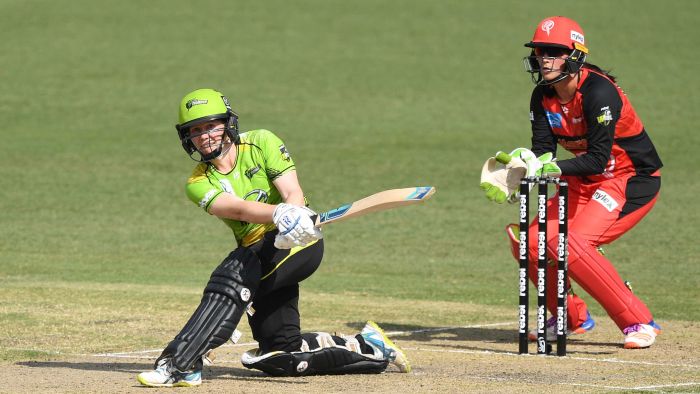Baseball has a rich history of influencing men’s cricket training, mostly in the field.
Key points:
- Sport scientist Jonathan Freestone has taken baseball techniques to improve scoring in women’s cricket
- A university study is tracking the improvement in players’ power hitting
- Baseball techniques have been used for a number of years, with Alex Blackwell one of the early adopters
Now the sport is starting to provide some inspiration for women’s cricket.
As skills and the entertainment factor continue to grow in the women’s game, so does its need for creativity.
And one idea has come in the form of a batting sensor, as used in Major League Baseball (MLB).
The Blast Motion sensor is attached to the end of the bat and records several metrics that can determine which strokes are most effective for a particular batter.
Australian sports scientist and senior lecturer at the University of Sydney, Jonathan Freeston, has been working as a research fellow with the Cleveland MLB team for the past two years.
His main objective has been to find new ways of testing athlete strength, mobility and power.
But before that, he worked with Cricket NSW for almost a decade, across their Blues, Breakers and youth development teams.
That pre-existing relationship led to an interesting project, linking baseball technology and the Women’s Big Bash League (WBBL).
There were 11 players from the Sydney Thunder and Sydney Sixers set-ups trialling the sensor prior to WBBL06.
Unfortunately, the timing of the study and number of challenges the cricketers were already facing this season due to COVID-19, halted its potential use in official match play.
But a study by a team at the University of Sydney, which has turned into a masters project, is predicting widespread use of the technology in coming years.
“It’s really exciting to be able to explore ways that we can take some of the learnings from Major League Baseball across to cricket,” Freeston said.
“The Blast Motion sensor that Cleveland uses also effectively measures a bunch of batting-related metrics and variables in cricket.
“Our early testing gave us a taste of what we might be able to do with bat speed and how hard women are able to hit the ball.
“The next step is to gather more data during net sessions and practice matches, so that’s something we’re looking forward to in 2021.”




Freeston is overseeing the ongoing masters project, taken on by Shaun Hardy — a strength and conditioning coach at Cricket NSW.
And although the sensor is small in size, the pair believe it could have a huge impact on the way athletes approach their craft.
“Technology like the use of this sensor is really about knowing more about your own game,” Freeston said.
“What’s really valuable is that it will tell you in detail where you are in comparison to your peers and which shots are more valuable for you.
“So, one of the things we’ve done for each individual is compare how hard they hit the ball during a cut shot, a drive, a pull and a slog sweep.
“We can work out their best go-to shots, so they know which one to use if they really need a boundary.
“It also helps us work out any weaknesses. We know the shots where they’ll need to develop more power, leading to more options in those moments.”
Alex Blackwell used baseball to turn her into a power-hitting force
Long before this study, Alex Blackwell was already embracing baseball techniques in her training.
The former Australian star might have copped some weird looks from peers for carrying a baseball bat around in her cricket kit.
But her biggest strength over the course of a 15-year career was the ability to reinvent her game as the sport progressed.




Assistant coach of the Sydney Thunder, Mark McInnes, worked closely with Blackwell during the time she spent in the WBBL.
The Thunder experienced success early on, winning the inaugural trophy under Blackwell’s captaincy.
But she still wanted to push her individual game further and become a destructive player.
So in the offseason, McInnes trained with her up to three times a week with a baseball bat.
And it paid off.
“Her six-hitting percentage went up by 400 per cent,” he told the ABC.
“She hit one six and 28 fours in the first year, and five sixes and 45 fours in the second.
“Alex became a power-hitter and one of the things that made her such a great player was that she could hit sixes in most games if she wanted to. She could turn it on or off.”




McInnes’s work as a batting coach mainly revolves around rotational power.
Trying to get an athlete to move through the shot from their hips right down to their ankles.
While the baseball training helped Blackwell do that, he says it also sharpened her hand-eye coordination.
“Because a baseball bat is round, there is less surface area,” McInnes said.
“So the first thing is you really have to focus on the contact point and nail the timing … If Alex was slightly out, she’d edge it. So making sure her swing was in sync played a part of it as well.
“We also used what we call ‘heavy balls’. Plastic balls filled with sand that require more force.
“After you’re used to hitting the heavier ball, you can hit a cricket ball further.”
Loading
McInnes too, is excited about the bat sensor that Cricket NSW and Sydney University are experimenting with.
But when it comes to Blackwell’s ahead-of-the-curve approach, he says it takes a special kind of athlete to think outside the box.
“I’ve coached in the female game for six years and there’s only been a handful of players try it,” he said.
“So maybe with this study, we might see a few more takers.”







